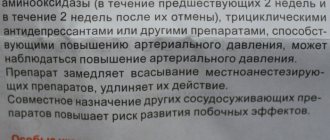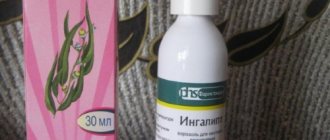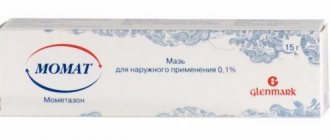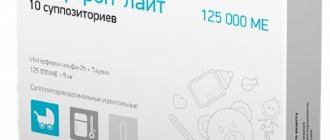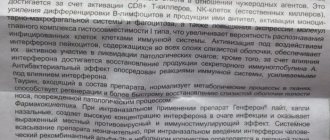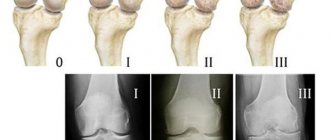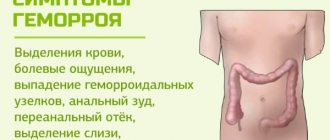Momat Rino Advance, 140 mcg+50 mcg/dose, 75 doses, metered nasal spray, 1 pc.
As with any long-term treatment, patients using Mo-mat Rhino Advance nasal spray for several months or longer should be periodically examined by a doctor for possible changes in the nasal mucosa, perforation of the nasal septum (very rare) and the possible development of systemic side effects. effects. If a local fungal infection of the nose or throat develops, it may be necessary to discontinue treatment with Momat Rhino Advance nasal spray and undergo special treatment. If persistent irritation of the nasopharynx develops, it is necessary to decide on stopping therapy. Patients who switch to treatment with Momat Rhino Advance nasal spray after long-term therapy with systemic glucocorticosteroids require special attention. Withdrawal of systemic corticosteroids in such patients can lead to insufficient adrenal function, the subsequent recovery of which may take up to several months. If signs of adrenal insufficiency appear, systemic corticosteroids should be resumed and other necessary measures taken. During the transition from treatment with systemic glucocorticosteroids to treatment with Momat Rhino Advance nasal spray, some patients may experience initial symptoms of systemic glucocorticosteroid withdrawal (for example, joint and/or muscle pain, fatigue and depression), despite a decrease in the severity of symptoms associated with damage to the nasal mucosa; such patients must be specifically convinced of the advisability of continuing treatment with Momat Rhino Advance nasal spray. The transition from systemic to local glucocorticosteroids may also reveal pre-existing allergic diseases such as allergic conjunctivitis and eczema that were masked by systemic glucocorticosteroid therapy. When intranasal steroids are used in higher than recommended doses, or in sensitive patients at recommended doses, systemic corticosteroid effects and adrenal suppression may occur. If such changes occur, the use of Momat Rhino Advance nasal spray should be gradually discontinued, in accordance with the procedures adopted for stopping the use of oral glucocorticosteroids. Patients treated with glucocorticosteroids have a potentially reduced immune responsiveness and should be warned of their increased risk of infection if exposed to patients with certain infectious diseases (eg, chickenpox, measles), as well as the need for medical advice if such exposure occurs . If signs of a severe bacterial infection appear (for example, fever, persistent and sharp pain on one side of the face or toothache, swelling in the orbital or periorbital area), immediate medical consultation is required. Glucocorticosteroids for nasal and inhaled use can cause the development of glaucoma and/or cataracts. Therefore, patients with changes in vision, as well as patients with a history of increased intraocular pressure, glaucoma and/or cataracts, should be closely monitored. Impact on the ability to drive vehicles and engage in other activities In rare cases, fatigue, fatigue, dizziness and weakness, which may be a consequence of the disease itself, may develop when using Momat Rhino Advance nasal spray. In such cases, you should avoid driving a vehicle and working with complex mechanisms.
Release form and composition
The drug is available in the form of a metered nasal spray, which is a suspension of white or almost white color (150 doses each in polyethylene bottles with a dosing device and a nasal adapter, one bottle in a cardboard package and instructions for use of Momata Rino Advance).
Composition per dose of spray:
- active ingredients: mometasone furoate – 50 mcg, azelastine hydrochloride – 140 mcg;
- auxiliary components: dextrose, benzalkonium chloride, carmellose sodium, citric acid monohydrate, neotame, Avicel RC-591 (sodium carmellose and microcrystalline cellulose), polysorbate-80, disodium edetate, sodium citrate, water for injection.
Contraindications
- age under 18 years;
- pregnancy and lactation;
- trauma to the nose with damage to the mucous membrane of the nasal cavity or recent surgery in the nasal cavity (use of Momat Rhino Advance is allowed only after complete healing of the wound);
- individual hypersensitivity to any component of the drug.
According to the instructions, Momat Rhino Advance should be used with caution (after consultation with a doctor and under his close supervision) in the presence of an untreated infection affecting the mucous membrane of the nasal cavity, active or latent tuberculosis infection of the respiratory tract, untreated bacterial, systemic viral or fungal infection or infection caused by Herpes simplex, affecting the eyes.
About competitors
Among the analogues of these drugs are Nasobek, Nasonex and Rinoklenil.
Nasobek is intended for the treatment and reduction of symptoms of allergic rhinitis; the active component of the drug is beclomethasone dipropionate, which is a corticosteroid and has an anti-inflammatory effect in the case of a runny nose.
Nasonex also contains mometasone furoate, which is effective for runny nose of various origins. Despite the identical composition, the drug costs an order of magnitude more than the described analogue.
Rinoclenil is a nasal spray of the glucocorticoid group, the active component of which is beclomethasone dipropionate. This substance quickly eliminates the symptoms of rhinitis, providing an effective antiallergic effect. One package of the drug contains 200 doses of this component, 100 mcg each, which determines its high cost in pharmacies.
Overdose
To date, there have been no reports of cases of drug overdose.
Azelastine, as a result of accidental ingestion of the suspension, can cause disorders of the nervous system (confusion, drowsiness), as well as hypotension and tachycardia. Treatment of these disorders is symptomatic.
In patients using Momat Rhino Advance for a long time or in combination with other corticosteroids, suppression of the hypothalamic-pituitary-adrenal system is possible. Given the low systemic absorption of mometasone in case of overdose, only temporary withdrawal of the drug and monitoring of the patient's condition are usually required. After stabilization of the condition, therapy can be resumed at the dose recommended by the doctor.
Drug interactions
Mometasone and azelastine are metabolized by different receptors, so no drug interactions between the substances are expected for this combination (in fixed doses).
Azelastine hydrochloride, when administered intranasally, does not enter into clinically significant drug interactions with other substances and drugs.
Mometasone in combination with loratadine is well tolerated by patients, without changing the plasma concentration of loratadine, as well as its main metabolite.
Side effects
- from the nervous system: often (< 1/10, > 1/100) - unpleasant taste (dysgeusia) and headache due to improper use of the drug (in case of excessive tilting of the head back during inhalation); very rarely (< 1/10000) - dizziness (the connection with the use of the drug has not been clearly established, since this reaction may be caused by the disease itself);
- from the gastrointestinal tract: rarely (< 1/1000, > 1/10000) - irritation of the pharyngeal mucosa, nausea;
- from the immune system: very rarely (<1/100, >1/1000) - hypersensitivity reactions, anaphylactoid reactions;
- from the respiratory system, chest and mediastinal organs: often - sneezing, ulceration of the nasal mucosa, discomfort in the nasal cavity (burning sensation, itching), nosebleeds, sinusitis, pharyngitis, upper respiratory tract infections;
- from the skin and subcutaneous tissues: very rarely - itching of the skin, rash, urticaria;
- other: very rarely - weakness, increased fatigue and drowsiness (these phenomena can be caused by the disease itself).
With long-term use of the drug in high doses, the development of systemic effects characteristic of GCS (due to the content of mometasone), including cataracts and glaucoma, is possible.
Pharmacological properties
Pharmacodynamics
Mometasone is a synthetic GCS (glucocorticosteroid). In small doses that do not lead to the development of systemic effects, it has anti-inflammatory and antiallergic activity. Mometasone increases the production of lipomodulin, which inhibits phospholipase A, an enzyme that slows down the release of arachidonic acid and its metabolic products (cyclic endoperoxides, prostaglandins).
Mometasone furoate prevents the accumulation of neutrophils at the vascular walls, resulting in a decrease in the production of lymphokines and the volume of inflammatory exudate; inhibits macrophage migration; slows down the processes of granulation and infiltration. Mometasone affects the final stages of allergies (by reducing the formation of a chemotaxis substance) and inhibits the development of anaphylactic shock and other immediate allergic reactions.
Azelastine is a phthalazinone derivative and is a long-acting antiallergic drug. Azelastine is a selective blocker of H1-histamine receptors that has antiallergic, membrane-stabilizing and antihistamine effects. It reduces exudation and capillary permeability, stabilizes mast cell membranes, preventing the release of leukotrienes, serotonin, histamine, platelet-activating factor and other biologically active substances that cause bronchospasm and contribute to the development of inflammation, as well as early and late allergic reactions.
Pharmacokinetics
When administered intranasally, the bioavailability of mometasone for systemic absorption does not exceed 1%. The drug is very poorly absorbed from the gastrointestinal tract. Mometasone, which enters the digestive system after inhalation and is absorbed into the blood, undergoes a primary passage through the liver and is metabolized before being excreted in urine or bile.
The bioavailability of azelastine hydrochloride after inhalation of Momata Rhino Advance is about 40%. The maximum plasma concentration is observed after 2–3 hours. After intranasal administration of a daily dose of azelastine hydrochloride (0.56 mg), its average equilibrium concentration in plasma is 0.65 ng/ml (2 hours after taking the drug). Administration of a double dose (1.12 mg per day) leads to a steady-state average plasma concentration of 1.09 ng/ml. Despite the high absorption, the systemic effect of azelastine hydrochloride after intranasal administration is approximately 8 times lower than after taking azelastine orally at a daily dose of 4.4 mg (the therapeutic oral dose of the drug for allergic rhinitis). In patients with allergic rhinitis, after intranasal administration of azelastine hydrochloride, its plasma concentration increases compared to healthy volunteers.
Azelastine hydrochloride is 80–90% bound to plasma proteins. Metabolism occurs in the liver with the participation of the cytochrome P450 system, resulting in the formation of desmethyl azelastine (an active metabolite). The main route of elimination is through the kidneys. The drug is excreted primarily in the form of inactive metabolites. T1/2 of azelastine averages 20 hours, and desmethylazelastine - approximately 45 hours.
